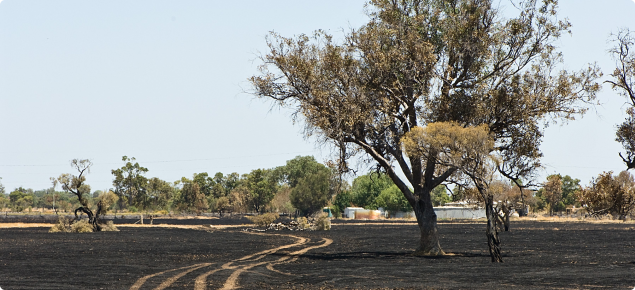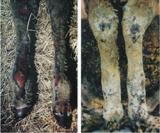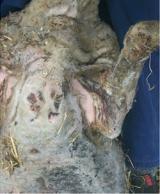Care for sheep and yourself after a fire
Often large numbers of sheep are affected when they mob themselves into corners of paddocks against fences, where they are burnt or suffocate. Burns sustained often reflect this behaviour, with animals on the outside burnt around the face or tail and those in the middle may completely escape injury.
Wool is a good insulator, protecting the sheep's body from intense radiant heat. Sheep in full wool are less likely to suffer severe burns than sheep offshears. The outside of the fleece can be quite charred, yet the underlying skin may be completely unaffected.
Emotions can run high during and after a fire: getting professional animal health and welfare advice can support sound decision making.
Initial assessment
Sheep able to walk should be yarded for assessment, usually the day after the fire or when it is safe to enter the property.
After a fire, teams from the Department of Primary Industries and Regional Development (DPIRD) are assigned to assess property damage, deal with animal welfare needs and refer any human welfare concerns to the appropriate agency. The team will assess livestock and destroy those animals assessed for euthanasia. See Figures 1 to 5 at the bottom of this page.
Animals can be divided into 4 groups:
- Category 1: destroy immediately
- Category 2: salvage slaughter (if practical)
- Category 3: keep and nurse
- Category 4: animals with no apparent damage.
Other things to assess are:
- availability of feed and water
- the owner's ability to provide necessary care and attention
- the prognosis for productive and reproductive performance of livestock.
Category 1: Destroy immediately
Sheep for humane destruction at this stage include:
- sheep that are unconscious or semi-conscious
- those down and unable to walk
- those with extensive burns to bare areas
- those with major swelling of the limbs
- those showing respiratory difficulties from smoke-damaged lungs.
Category 2: Salvage slaughter (if practical)
Moderately burnt sheep that will survive at least the next few days after a fire may be worth slaughtering for sale or use. These animals may be heavily singed on the wool with only minor burns to non-wool areas. The non-wool areas include the face, ears, lips, forelegs, teats, anus and between the legs.
Take note:
- It is very unlikely that animals in this category will be fit for transport. If there are any doubts about the health or ability of stock to cope with being transported, they should be assessed by a veterinarian or recognised DPIRD staff member, or they should not be transported.
- Bare areas with hardened cracking skin usually have subcutaneous oedema and congestion, causing difficulty with skinning and can result in carcase condemnation.
- The condition of even mildly burnt sheep can deteriorate rapidly: this needs to be considered when large numbers of sheep are affected and abattoirs are over-supplied.
Category 3: Keep and nurse
Mobile and alert animals with only moderate burns to less than 10–15% of their body are generally good candidates for keeping.
Make sure you:
- consult a veterinarian about treatment of burnt sheep that are suitable to keep. Secondary infection following burning is likely
- have suitable facilities, labour, fresh water and feed are readily available. Treatment and recovery is likely to be long and arduous, with no guarantee of success
- inspect the sheep each day for at least a week after being burnt, and those seen to be deteriorating or unable to drink should be humanely destroyed. Regularly check all animals, on burnt areas of the body and on the feet, for signs of flystrike
- provide high-protein feed when the burnt sheep are ready to eat (generally after a few days to a week) to aid healing
- place sheep on soft, level ground, especially if their feet are burnt. Sheep with minor visible cracking around the coronet will be very lame and sore.
If these sheep need agisting, and there are any doubts about the health or ability of the stock to cope with being transported, they should be assessed by a veterinarian or recognised DPIRD staff member, or they should not be transported.
Category 4: Animals without apparent damage
These are sheep that are apparently undamaged or have minor singeing of the wool and facial area, and have sound feet. They should survive but must be re-assessed in 5 to 7 days. Pay particular attention to breathing difficulties caused by smoke inhalation, which may take some time to become evident. Stock need to be yarded to inspect the sheep properly.
What to look for
Severe burns in sheep are generally confined to the bare areas of skin not protected by fleece wool: the udder, anus, vulva, lips, nose and face, belly, and most importantly the feet and legs.
Severe burns may not be obvious immediately after a fire, but after 2 to 3 days, the skin appears dry, scorched and leathery. There is often swelling and release of fluids or sloughed skin.
Feet and legs
The most important factor for survival is mobility. Often after a fire, sheep are forced to stand on burnt ground, resulting in hoof injuries in addition to leg burns sustained in the fire. Severely damaged legs will be swollen and the skin leathery with underlying tissue damage. These animals eventually go down and, unable to rise or walk to water and feed sources, die.
If hooves are lost, the animals must be destroyed, regardless of other burns. Walking directly on the pedal bones causes considerable pain. Cracking or exudation of the hooves at the coronet is clear evidence that the hoof will be shed within a few days; these sheep must be humanely destroyed.
The inside of the legs and feet
It is important to tip and examine the underside of affected sheep. The axilla and inguinal areas should be examined for severe burns that cause the skin to split and slough.
Burnt skin of sheep does not blister but will harden and crack over the following days, causing the sheep to become immobile and lethargic and preventing feeding. Even with intensive treatment, it is rarely possible to save sheep with greater than 15% of their body burnt (less if vital areas are burnt).
Face, lips and eyes
Burns to the face generally heal well and are not life threatening. However, swollen burnt lips hinder feeding and affected sheep may lose several kilograms. If the animal is unable to eat satisfactorily because of damaged lips, it may be necessary to destroy it on humane grounds.
Burns to the eyes or corneas may take several weeks to heal and often result in subsequent scarring causing blindness. Injuries to the eyelids will interfere with the normal blink reflex and the ability to clean the eye and protect it.
Nasal discharge, laboured breathing or abnormal sounds indicate smoke inhalation and respiratory burns. Affected sheep can develop lung abscesses and most die within a few days or weeks of being burnt.
Genitalia, anus and udders
Burns to the groin, udder, anus and vulva are unsightly and may take weeks to heal if a large area of skin is affected. The damage is not life-threatening provided there is no secondary infection and flies are kept away, and they eventually heal.
- Burns to the pizzle heal well, provided the swelling and scabs do not block the pizzle opening and prevent urination.
- Burns to the scrotum on rams also heal well, but sperm quality and hence fertility may be reduced for several months.
- The udders of ewes should be examined. Scar tissue can close the orifice of badly burned teats, but minor scabs will usually shed after a few weeks, leaving teats functional.
- Severe burns to the anus can cause faecal incontinence if sphincter muscles are damaged.
Other considerations
The decision to destroy affected sheep should be made on animal welfare grounds. It is not acceptable to allow animals to suffer for extended periods.
Other factors to be considered when assessing and dealing with burnt sheep:
- What is the availability of feed and water? Is there enough feed and water left on the property to sustain the remaining sheep or is agistment available?
- Is there adequate labour to provide the necessary care and attention for burnt stock?
- Are insurance arrangements adequate?
- Are remaining facilities, yards and fencing suitable and available?
- What is the prognosis for future productivity and reproductive performance?
Quick, thorough disposal of dead stock is most important because burnt carcasses will decompose rapidly and become a breeding place for flies. Such carcasses are then difficult to handle.
Your local Shire is the agency responsible for burial of dead stock, although the process is usually facilitated through DPIRD staff and Shire rangers.
Euthanasia
- The owner has primary responsibility for welfare decisions.
- An RSPCA officer or a general inspector (some rangers) can order the destruction of a suffering animal.
- A veterinarian can euthanase a suffering animal without owner or inspector approval only under very limited circumstances.
Disposal
Disposal is usually burial. In sensitive areas, such as catchment areas and areas with high watertables, burial may not be possible.
Acknowledgement: The information in this factsheet was sourced from the Victorian Department of Environment and Primary Industries.







